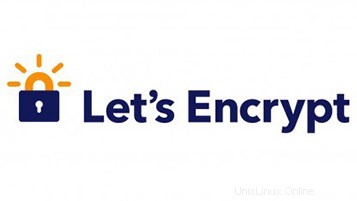
このチュートリアルでは、Let's Encrypt SSLforNginxをUbuntu18.04LTSにインストールする方法を紹介します。知らない人のために、Let's Encryptは無料のオープン認証局です( CA)Webサイトやその他のサービスに無料の証明書を提供します。このサービスは、Electronic Frontier Foundation、Mozilla、Cisco Systems、およびAkamaiによってサポートされています。残念ながら、LetsEncrypt.orgの証明書の有効期間は現在3か月です。つまり、次のことを行う必要があります。今のところ、四半期ごとに証明書を更新してください。
この記事は、少なくともLinuxの基本的な知識があり、シェルの使用方法を知っていること、そして最も重要なこととして、サイトを独自のVPSでホストしていることを前提としています。インストールは非常に簡単で、ルートアカウントで実行されていますが、そうでない場合は、'sudoを追加する必要があります。 ‘ルート権限を取得するコマンドに。 Ubuntu18.04LTSサーバーにNginx用のSSLを暗号化するステップバイステップのインストールを紹介します。
前提条件
- 次のオペレーティングシステムのいずれかを実行しているサーバー:Ubuntu18.04。
- 潜在的な問題を防ぐために、OSの新規インストールを使用することをお勧めします。
- サーバーへのSSHアクセス(またはデスクトップを使用している場合はターミナルを開く)
non-root sudo userまたはroot userへのアクセス 。non-root sudo userとして行動することをお勧めします ただし、ルートとして機能するときに注意しないと、システムに害を及ぼす可能性があるためです。
Ubuntu 18.04 LTSBionicBeaverにNginxのSSLを暗号化してインストール
手順1.まず、次のapt-getを実行して、すべてのシステムパッケージが最新であることを確認します。 ターミナルのコマンド。
apt-get update apt-get upgrade
ステップ2.Let’sEncryptSSLをUbuntu18.04LTSにインストールします。
まず、Certbotをリポジトリに追加します:
sudo add-apt-repository ppa:certbot/certbot sudo apt update sudo apt install python-certbot-nginx
ステップ3.サーバーブロックにドメイン名を設定します。
Certbotは、証明書を要求しているドメインと一致するserver_nameディレクティブを探すことにより、NginxのSSLの構成を自動化します。server_nameディレクティブを既に構成している場合以前は、手順4にスキップできます。
ステップ4.Certbotを使用して証明書を生成します。
まず、Certbotを使用して証明書を生成できるようになりました。idroot.usを独自のドメインに置き換えてください:
sudo certbot --nginx -d idroot.us -d www.idroot.us
緊急の更新とセキュリティ通知の場合に連絡できるメールアドレスを入力してください:
Please read the Terms of Service at https://letsencrypt.org/documents/LE-SA-v1.2-November-15-2017.pdf. You must agree in order to register with the ACME server at https://acme-v01.api.letsencrypt.org/directory ------------------------------------------------------------------------------- (A)gree/(C)ancel:
aとEnterを押して、利用規約に同意します:
Would you be willing to share your email address with the Electronic Frontier Foundation, a founding partner of the Let's Encrypt project and the non-profit organization that develops Certbot? We'd like to send you email about EFF and our work to encrypt the web, protect its users and defend digital rights. ------------------------------------------------------------------------------- (Y)es/(N)o:
メールアドレスをEFFと共有しない場合は、nキーとEnterキーを押します:
Obtaining a new certificate Performing the following challenges: http-01 challenge for idroot.us http-01 challenge for idroot.us Waiting for verification... Cleaning up challenges Deploying Certificate to VirtualHost /etc/nginx/sites-enabled/default Deploying Certificate to VirtualHost /etc/nginx/sites-enabled/default
成功した場合は、HTTPアクセスとhttpsアクセスの両方を有効にするか、すべてのリクエストを強制的にhttpsにリダイレクトするかを選択できます:
Please choose whether or not to redirect HTTP traffic to HTTPS, removing HTTP access. ------------------------------------------------------------------------------- 1: No redirect - Make no further changes to the webserver configuration. 2: Redirect - Make all requests redirect to secure HTTPS access. Choose this for new sites, or if you're confident your site works on HTTPS. You can undo this change by editing your web server's configuration. ------------------------------------------------------------------------------- Select the appropriate number [1-2] then [enter] (press 'c' to cancel):
2を押してEnterキーを押し、HTTPトラフィックをHTTPSにリダイレクトします:
Redirecting all traffic on port 80 to ssl in /etc/nginx/sites-enabled/default Redirecting all traffic on port 80 to ssl in /etc/nginx/sites-enabled/default ------------------------------------------------------------------------------- Congratulations! You have successfully enabled https://idroot.us and https://www.idroot.us You should test your configuration at: https://www.ssllabs.com/ssltest/analyze.html?d=idroot.us https://www.ssllabs.com/ssltest/analyze.html?d=www.idroot.us ------------------------------------------------------------------------------- IMPORTANT NOTES: - Congratulations! Your certificate and chain have been saved at: /etc/letsencrypt/live/idroot.us/fullchain.pem Your key file has been saved at: /etc/letsencrypt/live/idroot.us/privkey.pem Your cert will expire on 2018-12-05. To obtain a new or tweaked version of this certificate in the future, simply run certbot again with the "certonly" option. To non-interactively renew *all* of your certificates, run "certbot renew" - If you like Certbot, please consider supporting our work by: Donating to ISRG / Let's Encrypt: https://letsencrypt.org/donate Donating to EFF: https://eff.org/donate-le
ステップ5.自動更新Let’sEncryptを設定します。
Let's Encryptの証明書は3か月間有効で、定期的に更新を確認する必要があります。Certbotは1日に2回自動的に実行され、30日以内の証明書を更新します。有効期限:
sudo certbot renew --dry-run
おめでとうございます!Let'sEncryptが正常にインストールされました。Ubuntu18.04LTSBionicBeaverシステムにLet'sEncrypt SSLをインストールするためにこのチュートリアルを使用していただき、ありがとうございます。追加のヘルプや役立つ情報については、公式を確認することをお勧めします。 Webサイトを暗号化しましょう。